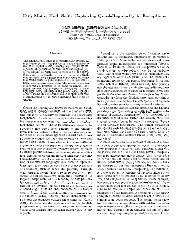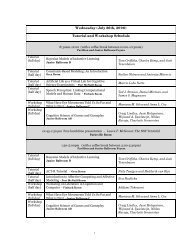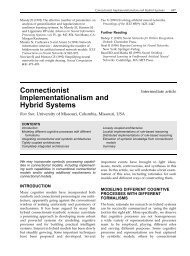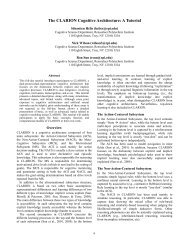python cheat sheet
python cheat sheet
python cheat sheet
Create successful ePaper yourself
Turn your PDF publications into a flip-book with our unique Google optimized e-Paper software.
Python Basics<br />
Whitespace matters! Your code will not run correctly if you use improper indentation.<br />
#this is a comment<br />
Basic Python Logic<br />
if:<br />
if test:<br />
#do stuff if test is true<br />
elif test 2:<br />
#do stuff if test2 is true<br />
else:<br />
#do stuff if both tests are false<br />
while:<br />
while test:<br />
#keep doing stuff until<br />
#test is false<br />
for:<br />
for x in aSequence:<br />
#do stuff for each member of aSequence<br />
#for example, each item in a list, each<br />
#character in a string, etc.<br />
for x in range(10):<br />
#do stuff 10 times (0 through 9)<br />
for x in range(5,10):<br />
#do stuff 5 times (5 through 9)<br />
Python Strings<br />
A string is a sequence of characters, usually used to store text.<br />
creation: the_string = “Hello World!”<br />
the_string = ‘Hello World!’<br />
accessing: the_string[4] returns ‘o’<br />
splitting: the_string.split(‘ ‘) returns [‘Hello’, ‘World!’]<br />
the_string.split(‘r”) returns [‘Hello Wo’, ‘ld!’]<br />
To join a list of strings together, call join() as a method of the string you want to separate the values in the list (‘’ if<br />
none), and pass the list as an argument. Yes, it’s weird.<br />
words = [“this”, ‘is’, ‘a’, ‘list’, ‘of’, “strings”]<br />
‘ ‘.join(words) returns “This is a list of strings”<br />
‘ZOOL’.join(words) returns “ThisZOOLisZOOLaZOOLlistZOOLofZOOLstrings”<br />
‘’.join(words) returns “Thisisalistofstrings”<br />
String Formatting: similar to printf() in C, uses the % operator to add elements of a tuple into a string<br />
this_string = “there”<br />
print “Hello %s!”%this_string returns “Hello there!”<br />
Python Tuples<br />
A tuple consists of a number of values separated by commas. They are useful for ordered pairs and returning several<br />
values from a function.<br />
creation: emptyTuple = ()<br />
singleItemTuple = (“spam”,)<br />
thistuple = 12, 89, ‘a’<br />
thistuple = (12, 89, ‘a’)<br />
note the comma!<br />
accessing: thistuple[0] returns 12
Python Dictionaries<br />
A dictionary is a set of key:value pairs. All keys in a dictionary must be unique.<br />
creation: emptyDict = {}<br />
thisdict = {‘a’:1, ‘b’:23, ‘c’:”eggs”}<br />
accessing: thisdict[‘a’] returns 1<br />
deleting:<br />
del thisdict[‘b’]<br />
finding: thisdict.has_key(‘e’) returns False<br />
thisdict.keys()<br />
returns [‘a’, ‘c’]<br />
thisdict.items()<br />
returns [(‘a’, 1), (‘c’, ‘eggs’)]<br />
‘c’ in thisdict returns True<br />
‘paradimethylaminobenzaldehyde’ in thisdict returns False<br />
Python List Manipulation<br />
One of the most important data structures in Python is the list. Lists are very flexible and have many built-in control<br />
functions.<br />
creation: thelist = [5,3,‘p’,9,‘e’]<br />
accessing: thelist[0] returns 5<br />
slicing: thelist[1:3] returns [3, ‘p’]<br />
thelist[2:] returns [‘p’, 9, ‘e’]<br />
thelist[:2] returns [5, 3]<br />
thelist[2:-1] returns [‘p’, 9]<br />
length: len(thelist) returns 5<br />
sort: thelist.sort() no return value<br />
add: thelist.append(37)<br />
return & thelist.pop() returns 37<br />
remove: thelist.pop(1) returns 5<br />
insert: thelist.insert(2, ‘z’)<br />
remove: thelist.remove(‘e’)<br />
del thelist[0]<br />
concatenation: thelist + [0] returns [‘z’,9,’p’,0]<br />
finding: 9 in thelist returns True<br />
[5,3,’p’,9,’e’]<br />
[5,3,’p’,9,’e’]<br />
[5,3,’p’,9,’e’]<br />
[5,3,’p’,9,’e’]<br />
[5,3,’p’,9,’e’]<br />
[5,3,’p’,9,’e’]<br />
[5,3,’p’,9,’e’]<br />
[3,5,9,’e’,’p’]<br />
[3,5,9,’e’,’p’,37]<br />
[3,5,9,’e’,’p’]<br />
[3,9,’e’,’p’]<br />
[3,’z’,9,’e’,’p’]<br />
[3,’z’,9,’p’]<br />
[‘z’,9,’p’]<br />
[‘z’,9,’p’]<br />
[‘z’,9,’p’]<br />
List Comprehension<br />
A special expression enclosed in square brackets that returns a new list. The expression is of the form:<br />
[expression for expr in sequence if condition] The condition is optional.<br />
>>>[x*5 for x in range(5)]<br />
[0, 5, 10, 15, 20]<br />
>>>[x for x in range(5) if x%2 == 0]<br />
[0, 2, 4]
Python Class and Function Definition<br />
function:<br />
def myFunc(param1, param2):<br />
“””By putting this initial sentence in triple quotes, you can<br />
access it by calling myFunc.__doc___”””<br />
#indented code block goes here<br />
spam = param1 + param2<br />
return spam<br />
class:<br />
<br />
class Eggs(ClassWeAreOptionallyInheriting):<br />
def __init__(self):<br />
ClassWeAreOptionallyInheriting.__init__(self)<br />
#initialization (constructor) code goes here<br />
self.cookingStyle = ‘scrambled’<br />
def anotherFunction(self, argument):<br />
if argument == “just contradiction”:<br />
return False<br />
else:<br />
return True<br />
theseEggsInMyProgram = Eggs()<br />
Files<br />
open:<br />
thisfile = open(“datadirectory/file.txt”) note: forward slash, unlike Windows! This function<br />
defaults to read-only<br />
accessing:<br />
thisfile.read() reads entire file into one string<br />
thisfile.readline() reads one line of a file<br />
thisfile.readlines() reads entire file into a list of strings, one per line<br />
for eachline in thisfile: steps through lines in a file








